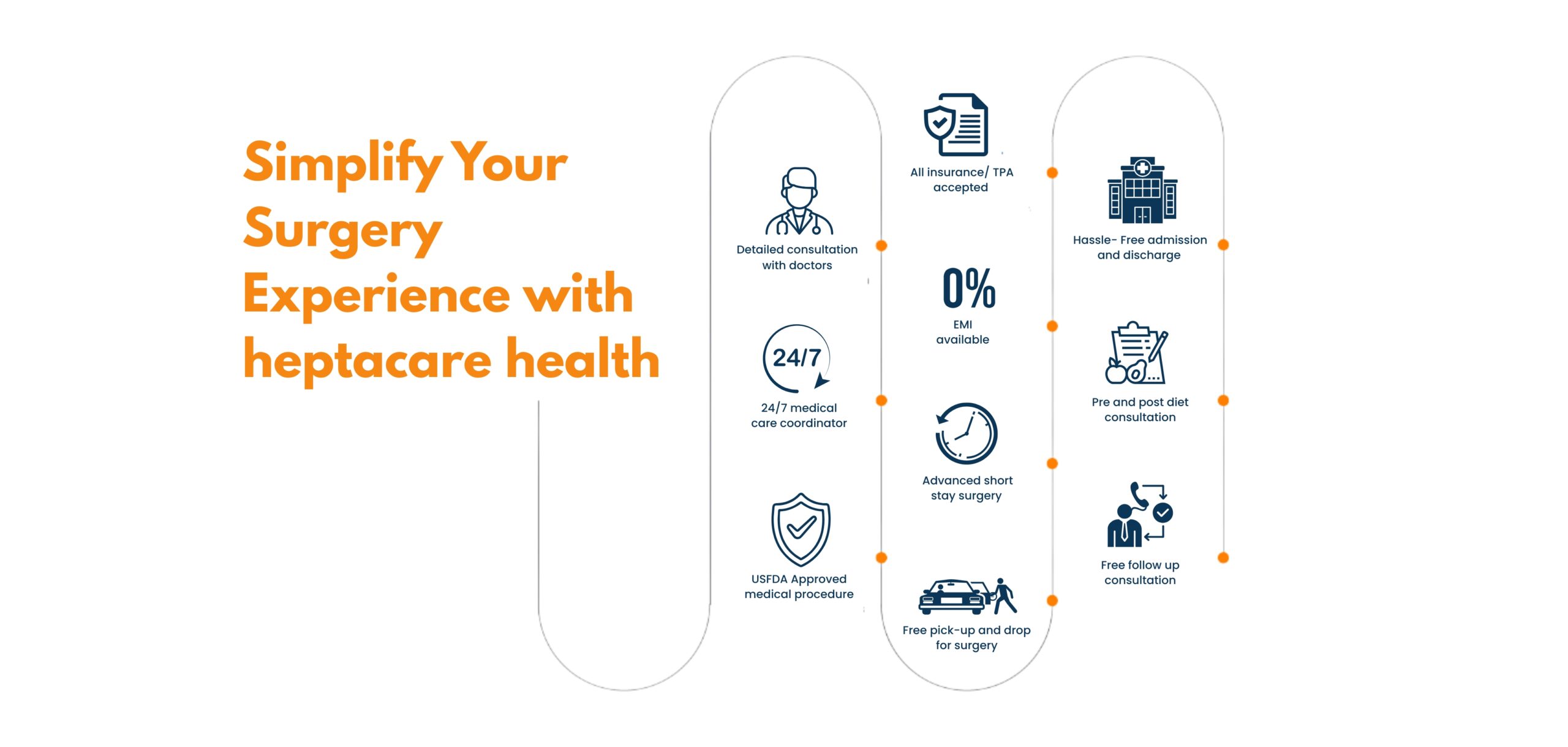A sebaceous cyst is a small, noncancerous lump beneath the skin caused by blocked sebaceous glands, often filled with oily or keratin material.
Want to change the shape of your nose? Rhinoplasty, also known as a nose job, is the best option for people to enhance their nose and reshape it as desired. If you have a nose deformity or you are simply unhappy with the nose shape, get in touch with HeptaCare Health and consult our expert rhinoplasty surgeons to plan the surgery. Book a consultation today.
Happy Patients
Disease
Hospitals
Cities
Rhinoplasty Surgery, commonly called nose job or nose plastic surgery, is a procedure that alters or modifies the shape of the nose for medical or cosmetic reasons. Due to the extent of modifications that can be done during rhinoplasty, the surgery is also referred to as nasal reconstruction. The modifications can be done to the bone, cartilage, skin, or all three as required.
Depending on the requirements, rhinoplasty is classified as functional rhinoplasty or cosmetic rhinoplasty. A cosmetic rhinoplasty focuses on the aesthetics of the nose and emphasizes changing its shape and size. Unlike this, functional rhinoplasty is reconstructive and addresses functional problems with the nose, such as breathing issues, deviated nasal septum, birth defects, nose injuries, etc.
It should be noted that rhinoplasty is a complex surgery. Therefore, when an individual considers a nose job, he/she should get in touch with an expert plastic/cosmetic surgeon who is well-trained and has ample experience in performing the procedure and delivering the best outcomes
Rhinoplasty can be divided into two types based on the technique used- open and closed. These two types are explained below:
Also known as external rhinoplasty, this procedure involves making a small incision in the columella to separate the nostrils. Then the doctor gets access to the underlying bone and cartilage. As the entire structure is exposed during the procedure, the surgeon can reshape the framework with higher precision.
The open technique is usually preferred when the patient’s nose is crooked or a marked reduction or enhancement needs to be done in the nasal tip. This approach may leave a scar behind, but it usually fades away with time and becomes barely noticeable.
Also known as endonasal rhinoplasty, this surgery is more intricate as it is performed by making incisions inside the nostrils so that they are completely hidden. An incision is made in both the left and right nostrils, and the changes in shape and size are made with minimal complications. The closed technique is less invasive and causes no visible scarring.
Besides the above-mentioned types, rhinoplasty surgery is also classified based on aesthetic and functional concerns. Based on this classification, rhinoplasty can be divided into the following types:
The above categories are generalized, and the specific techniques or approaches used for rhinoplasty will vary depending on the individual’s needs and the surgeon’s expertise.
Both men and women can consider rhinoplasty surgery as required. It can be considered to address any of the following:
If an individual is worried that his/her nose looks bulbous, upturned, too round, too large, too small, or droopy, rhinoplasty would be the most effective option to address all their concerns.
Though rhinoplasty is one of the most commonly performed plastic surgeries, not every individual can undergo it. Doctors follow specific eligibility criteria to determine the ideal candidate for nose plastic surgery. The criteria include the following:
The doctor analyzes these aspects during the initial consultations to determine if an individual is suitable for rhinoplasty surgery.
Before rhinoplasty surgery, a comprehensive evaluation and diagnosis is done to ensure that the individual is considering surgery for the right reasons and the procedure can address his/her specific concerns. The rhinoplasty surgeon will discuss the individual’s goals, expectations, and all other concerns regarding his/her nose. Along with this, he/she will evaluate the individual’s nasal anatomy, including the shape, size, symmetry, and structural characteristics.
Other evaluations will include the following:
While planning the surgery, the surgeon will discuss the potential risks and complications associated with the procedure and the individual’s expectations. Based on the diagnosis and evaluations, the surgeon will develop a personalized surgical plan tailored to the individual’s needs and goals and also take images from different angles to record the before and after changes.
Each rhinoplasty is unique in its own way, as the procedure is customized according to the patient’s requirements. Being a complex procedure, the surgery may take around 1 to 3 hours approximately, depending on the extent of modifications. The various aspects of the surgery are explained below in detail.
Rhinoplasty, or nose reshaping surgery, offers several potential benefits to individuals who choose to undergo the procedure. Here are some of the common benefits associated with rhinoplasty:
The benefits of rhinoplasty will vary for each patient, and it’s important to openly have a discussion with the surgeon to have realistic expectations
The rhinoplasty surgeon will provide clear and detailed instructions to prepare the individual for rhinoplasty surgery. The general guidelines include the following:
It’ll also be helpful to take time off work or school as recommended by the surgeon. On the day of surgery, the patient is also asked to sign a consent form before proceeding.
During a rhinoplasty, several steps are involved to reshape and enhance the nose. Here’s a general overview of what happens during a typical rhinoplasty procedure:
After the surgery, the patient is transferred to a recovery room where his/her vitals are monitored for the next few hours. The patient is usually discharged from the facility on the same day
Immediately after the surgery, the patient can expect significant swelling and bruising in the treated area, including around the eyes. In the first few days, the swelling will be maximum and will start to subside gradually as the nose heals. Besides this, there will be serious nasal congestion and stuffiness due to post-operative swelling and nasal splints. Due to this, the patient will have to breathe through the mouth.
Some discomfort or mild pain around the nose and face is also expected following rhinoplasty. The surgeon will prescribe pain medication to help manage any discomfort during the initial recovery period. The patient may also experience nasal drainage and breathing issues for the first few days.
The surgeon will provide a detailed guide consisting of dos and don’ts and a proper diet for a smooth and successful recovery.
The final results of rhinoplasty can take around 6 to 12 months to become apparent. The individual should understand this and be patient during the recovery to achieve the desired results.
The initial recovery time after rhinoplasty is 4 to 6 weeks, during which the swelling, bruising, redness, and other side effects will dissipate, and the patient will be able to resume normal activities. The general rhinoplasty recovery timeline will be as below.
In the first week, the swelling and bruising will be at their peak and gradually improve as the day progresses. The surgeon will monitor the patient’s recovery and remove external dressings or splints, if any. In the initial days, the patient will be advised to sleep with his/her head elevated and avoid certain activities that can increase the blood flow or strain the nose.
2-3 Weeks After Rhinoplasty:
In the second and third weeks, the swelling and bruising will continue to subside. It should be kept in mind that minor swelling will persist for several weeks to months. The nasal congestion and breathing issues will also start to improve as the swelling subsides and internal splints are also removed. The patient needs to continue to avoid strenuous activities, heavy lifting, and exercises that can impact the nose. Protect the nose from accidental trauma and avoid even blowing the nose forcefully.
1-3 Months After Rhinoplasty:
While most of the visible swelling resolves within 2-4 weeks, it may take several months for the final results to manifest as the nose fully settles into its new shape. As the healing progresses, the nasal contours refine, and the appearance becomes more refined and natural. The patient will still have to make follow-up appointments with the surgeon to monitor his/her progress.
As mentioned above, the final results of rhinoplasty can take longer to appear, usually a year or so. Throughout the recovery process, the patient will have to take several precautions and follow the surgeon’s instructions strictly to get the desired results.


Based on 7721 Recommendations | Rated 4.68 Out of 5
Happy Patients
Clinics
Cities
Surgeries
Doctors
Hospitals

A beard transplant is a cosmetic procedure that restores or enhances facial hair by transplanting hair follicles from the scalp to the beard area.

Vaginoplasty is a surgical procedure that tightens or reconstructs the vaginal canal to improve function, appearance, or both.

Treat anal fistula with safe, advanced procedures.
Minimally invasive care with faster recovery.

A breast lump is a swelling or mass in the breast that can be benign (non-cancerous) or, in some cases, a sign of breast cancer.

A tummy tuck, or abdominoplasty, is a cosmetic surgery that removes excess fat and skin from the abdomen and tightens the muscles for a flatter, firmer tummy.

A double chin is a layer of excess fat beneath the chin, often caused by weight gain, ageing, or genetics, and can be reduced through cosmetic treatments or lifestyle changes.

A sebaceous cyst is a small, noncancerous lump beneath the skin caused by blocked sebaceous glands, often filled with oily or keratin material.

A lipoma is a soft, benign lump made up of fatty tissue that grows slowly under the skin and is usually painless and harmless.

Liposuction is a cosmetic surgery that removes excess fat deposits from specific body areas to improve body shape and contour.

● lipoma laser surgery cost in Vizag ● low-cost lipoma surgery in Hyderabad ● cashless lipoma treatment near me ● painless lipoma surgery in Vijayawada ● lipoma treatment with insurance in Vizag ● lipoma removal surgery cost in Hyderabad ● lipoma operation packages in Vijayawada ● affordable lipoma treatment near me ● lipoma laser treatment clinic in Hyderabad ● lipoma doctor consultation charges in Vizag ● best lipoma surgery cost in Vijayawada ● lipoma treatment hospital near me ● lipoma laser operation price in Hyderabad ● low-cost lipoma laser treatment in Vizag ● lipoma removal cost near me ● lipoma treatment with EMI in Vijayawada ● lipoma surgery specialist near me ● lipoma surgery packages in Hyderabad ● lipoma treatment clinic near me ● lipoma laser surgery near me
Disclaimer: **The result and experience may vary from patient to patient.. ***By submitting the form or calling, you agree to receive important updates and marketing communications.
Getting an accurate diagnosis can be one of the most impactful experiences that you can have.

cure with care
Copyright © 2025. All rights reserved.
Consult with our expert surgeon for more than 50+ diseases
Happy Patients
Hospitals
Cities